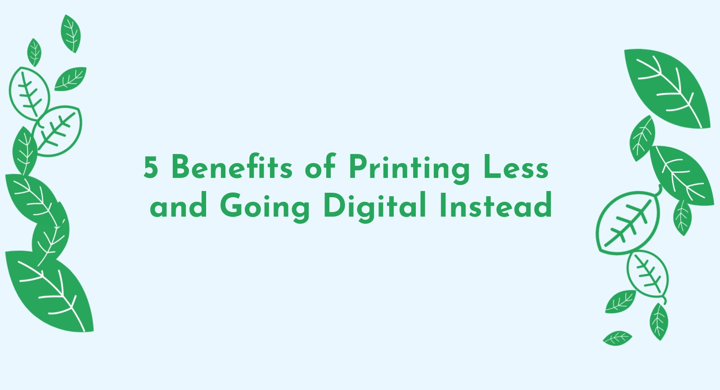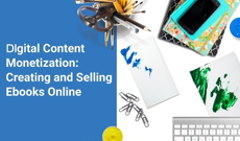The coronavirus pandemic has forced us to rethink our personal and work lives, with face masks becoming a must-wear accessory and home offices a new normal. While some industries have adjusted to the changes enviably and moved all their communications online, others haven’t been this lucky. They’ve been depending on physical assets for too long, so there’s no way the transition to the digital space would be smooth for them.
Take restaurants with fancy menus that cost big money to print, retailers with their merchandise, manufacturers with product items they want to showcase. How do you move a hundred page catalog with wallpaper samples to the web?!
Clearly, new strategies have to be developed even if not everyone is prepared to consider them—and they’ll be more than useful in the long run. After all, the shift from physical to digital is required and justified by what consumers have come to realize due to the pandemic: printed and other physical products aren’t safe. This concern isn’t likely to disappear any time soon because the consequences of COVID-19 will be chasing us well into 2021, if not further.
So moving maximum of your assets into the digital realm, away from print and other offline formats, is definitely a necessity. But how beneficial is this new way for businesses? We did some digging and unveiled 5 top benefits of printing less and going digital instead.
#1 Digital Formats Are Safer to Utilize
And we’re not even talking about web security here, even though there’s a variety of bullet-proof ways to protect your content online. Digital doesn’t require the physical touch, which is a huge advantage these days. If you’re using your own phone or tablet, you don’t have to worry whose hands have touched this catalog or that menu. You can simply access the digital version of the document. Printed produce is no longer considered 100% safe, and it’s just our new reality. If you haven’t yet adjusted to this simple truth, you should.
Same goes for retail products. How lucky are we that we can simply order goods online without having to browse in-store when the risks of getting infected through touch are high? The number of digital shoppers has increased rapidly in 2020, reaching 2.02 billion. This includes both B2C and B2B sales, so you might want to jump on that wagon asap and move your merchandise online if you haven’t already. Online stores make customers feel secure while shopping, so offering your products on the web can add an extra layer of trust into your relationship with your consumers—if you’re taking care of their online shopping needs, they’ll later make repeat purchases offline, too.
Perhaps the most striking and relatable example of how digital formats now dominate physical copies can be found just around the corner in your local coffee shop or restaurant. Have you noticed how many have cut down or completely disposed of printed menus? Some now have big boards with menu items written on them, others offer tablets that they can wipe after every use. And the most tech-savvy have moved on to online menus available by scanning QR-codes. This simple yet effective tech allows restaurateurs to stay on top of the game and provide guests with the safety they expect from any business today. The codes are displayed at the counter or even as stickers at every table, so that customers can look through digital menus right in their phones. Often, such online menus come in the form of flipbooks, just like the one below. Go ahead and scan the QR-code to see the menu.
Create yours
#2 Digitization Is a Step toward a Safer Environment
Did you know that over the past 10 years wildfires claimed an average of 6.8 million acres annually in the US alone? And the 2020’s devastating fires in Australia burned an estimated 46 million acres. These staggering numbers are but a part of the global environmental crisis. Just imagine the amount of trees perished in the fires, and then complete the equation with the trees that are cut down annually for the paper industry. Sure, the trees may be replanted afterward, but a vast amount of paper still goes to waste. The sad truth is that whatever you’re using paper for—annual reports, sales catalogs, or monthly magazines—they’ll be disposed of quickly, eliminating the efforts invested in them. So why not cut down paper, instead of trees?
Going green not only addresses your corporate social responsibility, but also improves your brand image and presents you as an eco-friendly company. Printing is a thing of the past anyway—no one wants to carry around leaflets and brochures that you give them. However, if you choose a digital format, you’ll bring a game changer into your business. Your customers and employees will always have the materials you produce at hand, ready to be studied on the go at a convenient time. There’s a bunch of digital formats to choose from: your classic Word documents or PDFs, online flipbooks, web presentations and slideshows, different ebooks. Each of these formats has its pros and cons, for sure, but they all prevail over print in one way or another.
For instance, a 300+ page catalog would definitely function better digitally, wouldn’t you agree? A weightless document easy to access on any device and navigate around—well, it speaks for itself. And it saves trees, because you’ll be emailing it directly to several clients at a time, instead of printing out multiple copies they’ll likely get rid of. Basically, you’ll be giving your clients a choice of when and how to use your documents!
Launching a green initiative at your company is a big step. You can start by moving away from printing and then expand your initiative by partnering with other green companies. We know what we’re talking about: FlippingBook will plant a tree for anyone with Tree Nation. Contact us to learn how you can participate.
#3 Less Paper Means Less Money Spent
With FlippingBook, we no longer have the need to print our Course Directory, so we save over $20K per year in printing costs.
If you’re not too worried about offline assets being unsafe to use and you’re not ready to launch a green campaign, there’s another reason to give up printing. It saves costs. This may be a trivial reason, but it certainly is convincing. Instead of spending thousands of dollars on physical copies of your documents, you can invest in just one tool that will digitize them.
Come to think of it, printing can be considered a needless expense. When 50% of all waste from businesses is composed of paper, it raises the question of whether businesses need this much paper. Drafts certainly don’t need to be printed, and even the final versions of documents can be issued in a digital format of your choice. The trick is to choose a format that looks professional—this way, you’ll be known as an innovative company open to new technologies.
Printing is a high expense not just in terms of money, but also in man-hours. You need a whole crew to publish a magazine: copywriters, photographers, designers, marketers, technicians. The list goes on and on. And then to have all that effort go to waste when the magazine is thrown in the trash? Doesn’t seem fair. On the other hand, a digital magazine will live on forever—or at least for as long as you’d like. And your crew will know their work is out there, always available for viewing.
#4 Print Doesn't Offer the Diversity Your Audience Wants
Printing definitely isn’t a superior format in terms of interactivity. Whether colored or black-and-white, paper is still paper. It’s flat and unengaging compared to the variety of formats available in the digital space.
Take GIFs and pop-ups, for example. They enliven the page your readers are on, serving as tools to entice and educate them at the same time. You can add graphs in the form of GIFs to make any report more visual and engaging. And pop-ups work well in product catalogs, where people can see an item up close instead of zooming in on the details.
And of course, there’s video, a format that print simply can’t catch up with. It’s been a life-saver for some manufacturers during the pandemic. Unable to showcase their products offline, they’ve had to digitize their catalogs and add videos right where product samples used to be. Of course a video won’t be able to convey the texture of tiles or wallpaper, but it’s still visual enough for consumers to be hooked.
#5 You Can Put All That Space to Better Use
Does your company keep a stock of old reports? Piles on piles of financial data? Or perhaps archives with outdated magazines, corporate brochures, unused event leaflets? Honestly, there’s so much you can do with that storage space! Redecorate it to make an additional office room; create a place where employees can chill with a coffee and a quick chat; or throw some yoga mats in there for a stretching session or even a power nap! The possibilities for improving this space are endless.
And no need to wonder what to do with all those paper resources. It’s a two-step process: first, you digitize them, and then recycle! Now, the digitization might take a while to figure out and then carry out, as any other new process would. A good start here would be to scan your content and then you can convert it into any digital document you want—from PDFs to engaging online flipbooks. Once you’ve nailed it, you’ll enjoy the ease of storing your archives digitally. And as for recycling, it’s pretty straightforward and self-explanatory. Just find a recycling program that suits your company best and reflects your values.
Go Digital Today
Have we convinced you that giving up printing and other offline assets is the clear (and engaging!) way forward? It doesn’t just keep your clients healthy and safe, but it also helps the environment. Not to mention the resources you’ll be saving if you move away from printing: money, man-hours, collective efforts, and office space.
Go digital with FlippingBook
Try for free








